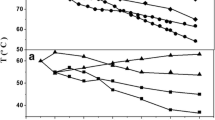Abstract
The effects of the type and amount of the surfactant and cosurfactant on the miniemulsion polymerization of acrylate monomers were studied, and the comparison of the kinetics between miniemulsion polymerization and conventional emulsion polymerization was discussed in the presence of reactive surfactant allyloxy nonylphenol propyl polyoxyethylene (10), ether sulfate (DNS-86), and reactive cosurfactant stearyl methacrylate (SMA). The results showed that the obtained polyacrylate miniemulsion had a high monomer conversion rate and a low coagulum fraction, which were affected little by the surfactant and cosurfactant type. When the surfactant and cosurfactant amounts were all 2 wt%, the contact angle of the prepared polyacrylate miniemulsion with DNS-86/SMA and the water absorption fraction of the latex film were 39° and 8.3 wt%, respectively. FTIR results confirmed that DNS-86 and SMA took part in the polymerization of acrylate monomers. In the miniemulsion polymerization of acrylate monomers with DNS-86/SMA, monomer droplet nucleation was the main nucleation style.








Similar content being viewed by others
References
Fonseca, GE, McKenna, TFL, Dubé, MA, “Preparation of Stable Miniemulsions of Poly(2-ethyl hexyl acrylate-co-vinyl acetate).” Macromol. Symp., 289 72–85 (2010)
El-Aasser, MS, Sudol, ED, “Miniemulsions: Overview of Research and Applications.” J. Coat. Technol. Res., 1 20–31 (2004)
Agirre, A, Nase, J, Degrandi, E, Creton, C, Asua, JM, “Miniemulsion Polymerization of 2-Ethylhexyl Acrylate. Polymer Architecture Control and Adhesion Properties.” Macromolecules, 43 8924–8932 (2010)
Huang, H, Zhang, HT, Hu, F, Ai, ZQ, Tan, BE, Cheng, SY, Li, JZ, “Miniemulsion Copolymerization of Styrene and Butyl Acrylate Initiated by Redox System at Lower Temperature: Reaction Kinetics and Evolution of Particle-Size Distribution.” J. Appl. Polym. Sci., 73 315–322 (1999)
Zhang, XY, Wei, X, Yang, WX, Li, YJ, Chen, HQ, “Characterization and Properties of Gradient Polyacrylate Latex Particles by Gradient Emulsion Polymerization.” J. Coat. Technol. Res., 9 765–774 (2012)
Roberge, S, Dubé, MA, “The Effect of Particle Size and Composition on the Performance of Styrene/Butyl Acrylate Miniemulsion-Based PSAs.” Polymer, 47 799–807 (2006)
Durand, A, Marie, E, “Macromolecular Surfactants for Miniemulsion Polymerization.” Adv. Colloid Interface Sci., 150 90–105 (2009)
Kim, N, Sudol, ED, Dimonie, VL, El-Aasser, MS, “Comparison of Conventional and Miniemulsion Copolymerizations of Acrylic Monomers Using Poly(vinyl alcohol) as the Sole Stabilizer.” Macromolecules, 37 2427–2433 (2004)
Lim, MS, Chen, H, “Miniemulsion Polymerization of Styrene with a Block Copolymer Surfactant.” J. Polym. Sci. Part A: Polym. Chem., 38 1818–1827 (2000)
Cismaru, L, Hamaide, T, Popa, M, “Novel Polymeric Surfactants and Their Applications in Miniemulsions.” E-Polymers, (2008). doi:10.1515/epoly.2008.8.1.508
Bohórquez, SJ, Asua, JM, “Particle Nucleation in High Solids Batch Miniemulsion Polymerization Stabilized with a Polymeric Surfactant.” J. Polym. Sci. Part A: Polym. Chem., 46 6407–6415 (2008)
Faridi-Majidi, R, Sharifi-Sanjani, N, “Emulsifier-Free Miniemulsion Polymerization of Styrene Using a Cationic Initiator.” J. Appl. Polym. Sci., 106 3515–3520 (2007)
Guo, JX, Pan, QH, Huang, C, Zhao, YB, Ovyang, XB, Huo, YH, Duan, SS, “The Role of Surfactant and Costabilizer in Controlling Size of Nanocapsules Containing TEGDMA in Miniemulsion.” J. Wuhan Univ. Technol., 24 1004–1006 (2009)
Bonnefond, A, Paulis, M, Bon, SAF, Leiza, JR, “Surfactant-Free Miniemulsion Polymerization of n-BA/S Stabilized by NaMMT: Films with Improved Water Resistance.” Langmuir, 29 2397–2405 (2013)
Che Man, SH, Mohd Yusof, NY, Whittaker, MR, Thickett, SC, Zetterlund, PB, “Influence of Monomer Type on Miniemulsion Polymerization Systems Stabilized by Graphene Oxide as Sole Surfactant.” J. Polym. Sci. Part A: Polym. Chem., 51 5153–5162 (2013)
El-Jaby, U, Cunningham, M, McKenna, TFL, “The Advantages of in Situ Surfactant Generation for Miniemulsions.” Macromol. Rapid. Comm., 31 558–562 (2010)
Ni, PH, Zhang, MZ, Ma, LH, Fu, SK, “Poly(dimethylamino) Ethyl Methacrylate for Use as a Surfactant in the Miniemulsion Polymerization of Styrene.” Langmuir, 22 6016–6023 (2006)
Huang, HZ, Lu, DP, Shen, L, Guan, R, “Reactive Surfactant in the Emulsion Copolymerization of Methyl Methacrylate and Octyl Acrylate.” J. Macromol. Sci., Part A: Pure Appl. Chem., 45 242–247 (2008)
Wang, X, Sudol, ED, El-Aasser, MS, “Mechanism of Emulsion Polymerization of Styrene Using a Reactive Surfactant.” J. Polym. Sci. Part A: Polym. Chem., 39 3093–3105 (2001)
Lu, DP, Xie, J, Shen, L, Zhao, Q, Yuan, TT, Guan, R, “Role of Three Different Carboxylic Monomers in Acrylate Emulsion Copolymerization in the Presence of Reactive Emulsifier.” J. Appl. Polym. Sci., 125 2807–2813 (2012)
Xu, L, Xu, L, Dai, WS, Tsuboi, T, Xie, HD, “Preparation and Characterization of a Novel Fluoro-Silicone Acrylate Copolymer by Semi-Continuous Emulsion Polymerization.” J. Fluor. Chem., 153 68–73 (2013)
Urbani, CN, Nguyen, HN, Monteiro, MJ, “RAFT-Mediated Emulsion Polymerization of Styrene Using a Non-ionic Surfactant.” Aust. J. Chem., 59 728–732 (2006)
Blackley, DC, Emulsion Polymerization. Applied Science Publisher Ltd., London, 1975
Vorwerg, L, Antonietti, M, Tauer, K, “Electrophoretic Mobility of Latex Particles: Effect of Particle Size and Surface Structure.” Colloids Surf. A: Physicochem. Eng. Asp., 150 129–135 (1999)
Landfester, K, Bechthold, N, Förster, S, Antonietti, M, “Evidence for the Preservation of the Particle Identity in Miniemulsion Polymerization.” Macromol. Rapid. Comm., 20 81–84 (1999)
Bechthold, N, Landfester, K, “Kinetics of Miniemulsion Polymerization as Revealed by Calorimetry.” Macromolecules, 33 4682–4689 (2000)
Sajjadi, S, Jahanzad, F, “Comparative Study of Monomer Droplet Nucleation in the Seeded Batch and Semibatch Miniemulsion Polymerisation of Styrene.” Eur. Polym. J., 39 785–794 (2003)
Author information
Authors and Affiliations
Corresponding author
Rights and permissions
About this article
Cite this article
Li, H., Ren, X., Lai, X. et al. Kinetics and effect of surfactant and cosurfactant on miniemulsion polymerization of acrylate monomers. J Coat Technol Res 11, 959–966 (2014). https://doi.org/10.1007/s11998-014-9601-z
Published:
Issue Date:
DOI: https://doi.org/10.1007/s11998-014-9601-z




